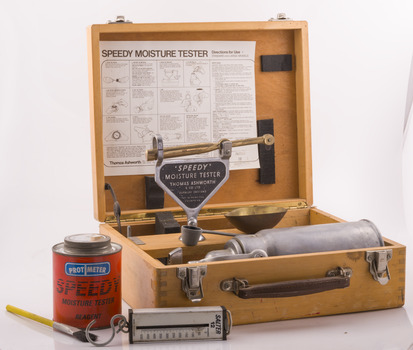Historical information
The most common technique to measure fuel moisture content in Victorian forests until recently was the Speedy Moisture Meter - which is essentially a pressure cylinder.
Originally developed in England during the 1920s for measuring moisture in wheat and other grains it was adapted for Australian forest fuels in the 1950s.
Fuel was first ground using a Spong domestic food mincer, often attached to the bullbar of a vehicle, and a small measured (using the beam balance) sample placed into the Speedy together with a measured amount of calcium carbide and then sealed. The chemical reaction between the moisture in the fuel and the calcium carbide created acetylene gas; the pressure of which was read on the external dial which gave the read-out as the moisture content (percentage of net weight) of the sample.
There were important techniques with preparing the minced samples, using the chemical and the subsequent cleaning of the Speedy to give reliable readings, but it was quick, inexpensive, robust, portable and practical in the field - it gave readings which were reproducible to within +/- 0.5% moisture content. It was used routinely before igniting a fuel reduction burn or measuring fuel moisture differentials on slash burns.
In about 1996, Karen Chatto and Kevin Tolhurst from the Department’s Creswick Research Station developed the Wiltronics Fuel Moisture meter which measured electrical resistance.
Significance
First reliable tool for measuring bushfire fuel moisture content in the field
Physical description
Speedy Moisture Meter in wooden box
Inscriptions & markings
manufacture's marks and instructions on use






